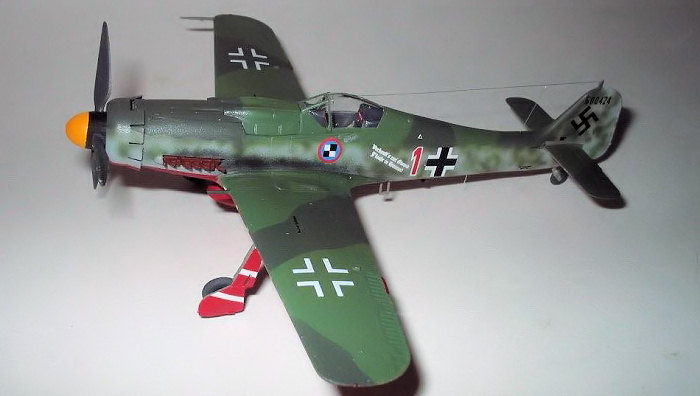
| KIT #: | 80228 |
| PRICE: | $10.00 MSRP |
| DECALS: | Two options |
| REVIEWER: | Brian Baker |
| NOTES: |

| HISTORY |
The Focke Wulf FW-190D-9 was the ultimate development of the famous FW-190 series. Many kits have been issued of this aircraft, and its history is well known to modelers and historians alike. There has probably been more information published about the FW-190 than any other World War II fighter, so it does not need to be repeated here.
| THE KIT |
The kit comes with a small, four-page
instruction booklet, in color, which includes an exploded diagram showing how to
assemble the kit, and two sets of four view color drawings giving painting and
marking details. The only thing I would question is the
 inclusion
of a red propeller on the JV44 aircraft. Iíve never heard of late war
Luftwaffe aircraft with this feature.
inclusion
of a red propeller on the JV44 aircraft. Iíve never heard of late war
Luftwaffe aircraft with this feature.
This kit represents a totally
different approach to modeling, and perhaps that is what makes this series
unique. While most plastic kits are aimed at the serious modeler with serious
selling prices, Hobby Boss is apparently aiming at the neophyte modeler, one
without a lot of experience or sophistication. The kits in this series, and
there are many, are highly detailed, snap-together kits that are reasonable
accurate, and which can be upgraded by serious modelers into state-of-the-art
models. The main features are simplicity and ease of construction, and a child
under ten years of age could easily
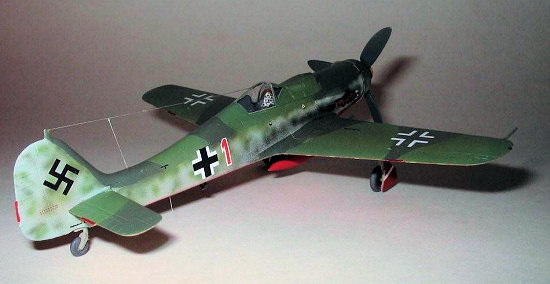 build one of these into an acceptable model.
build one of these into an acceptable model.
I think that the value of this type of kit is that it provides a chance for an inexperienced modeler to buy a kit at a reasonable price, and assemble it into a good looking model without expert modeling skills. We know that few kids today build plastic models like our older generation did (I started out with wooden models) and these just might provide enough competition with video games and computers, but probably not girls, to get some younger people into the modeling fraternity.
The model comes packed in a vacuformed container within the box, so damage in shipment is almost impossible. The parts are snapped into place, preventing any movement. There are only 26 parts in the kit, including a nearly solid fuselage and a one piece wing. These snap together, although the serious modeler will want to use glue. The upper cowling is cast separately, along with the forward cowling and radiator assembly. The prop snaps into place easily, and the horizontal tail units snap into place very securely. The landing gear is designed to that it cannot be installed incorrectly, and the gear legs snap into position better than more complicated kits. This kit is pretty hard to screw up.
| CONSTRUCTION |
This kit is almost idiot-proof, unless we can produce better idiots. It is a quick build for anyone with even a little experience, but does require painting and detailing, just like any other kit. I only used filler in one place, where the fuselage joins the wing section just ahead of the tail wheel. Otherwise, very little sanding was required, and flash was almost nonexistent.
| COLORS & MARKINGS |
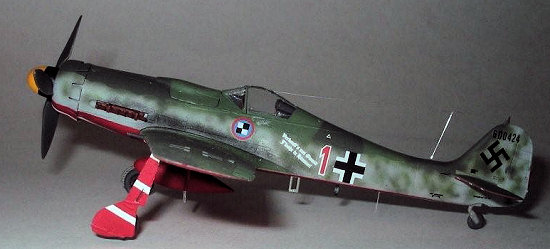 Decals are provided for two
aircraft. Most colorful is the FW-190D-9 of JV44, the ďProtection FlightĒ which
covered the landing and takeoff operations of the ME-262ís at the end of the
war. These aircraft were painted red underneath, with white stripes, for
identification by flak crews, meaning ďFritz, shoot at someone else. Iím one of
us.Ē The other aircraft is an FW-190D-9 of IV/JG3, which operated from several
German airfields in 1945.
Decals are provided for two
aircraft. Most colorful is the FW-190D-9 of JV44, the ďProtection FlightĒ which
covered the landing and takeoff operations of the ME-262ís at the end of the
war. These aircraft were painted red underneath, with white stripes, for
identification by flak crews, meaning ďFritz, shoot at someone else. Iím one of
us.Ē The other aircraft is an FW-190D-9 of IV/JG3, which operated from several
German airfields in 1945.
Unlike some other kits, the decals do not include either the white stripes or the red and yellow fuselage bands associated with JG3. The marking information appears to be accurate enough according to my references. Unfortunately, I had already built models of both of these aircraft, so I took out my trusty Squadron Walk-Around for the FW-190D and found another JV44 aircraft, ďRed 1Ē. Decals were provided by an old Airfix FW-190D-9, and these were excellent. I did use some of the stenciling that came with the kit, and it worked out pretty well. At least I could read some of the inscriptions, even though the kit instructions did not tell where the stenciling actually went. This is where reference material comes in handy.
PROBLEMS
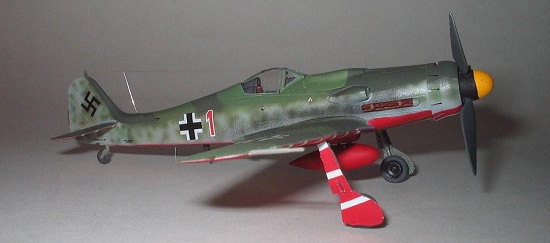 The kit does have some problems that
a serious modeler will want to address. There is virtually no cockpit detail
except for a seat, and the instrument panel space is too far back. (This is hard
to see once the canopy is on, so it isnít a big deal.) The landing gear doors
and annular radiator behind the prop have intricate detail, but unfortunately,
it bears little relationship to the actual airplane. Two headrests are provided,
and both are close to accurate, although only the bubble canopy is provided.
However, the Tamiya and Hasegawa FW-190 kits have an identical flat canopy if
you want to build that version. The DF loop antenna is way too smallódiscard it
and use another. The exhaust stacks are also pretty bad, and probably should be
replaced. Iíll do this later with my model. The cowling above the engine is not
quite wide enough, creating a visible notch along the upper fuselage where it
should be smooth. The last issue is the propeller. There were two props used on
FW-190D-9ís, the VS 10 and VS 111, according to Squadron. Most of the photos
Iíve seen of these aircraft show the more rounded VS 10 prop. The VS 111 has
more pointed tips, and this is the prop included in the kit. It may be accurate,
but Iíve seen few photos of any FW-190D-9 with this prop. I almost replaced it
with a spare Airfix FW-190D-9 prop, which is more accurateóbut I didnít.
The kit does have some problems that
a serious modeler will want to address. There is virtually no cockpit detail
except for a seat, and the instrument panel space is too far back. (This is hard
to see once the canopy is on, so it isnít a big deal.) The landing gear doors
and annular radiator behind the prop have intricate detail, but unfortunately,
it bears little relationship to the actual airplane. Two headrests are provided,
and both are close to accurate, although only the bubble canopy is provided.
However, the Tamiya and Hasegawa FW-190 kits have an identical flat canopy if
you want to build that version. The DF loop antenna is way too smallódiscard it
and use another. The exhaust stacks are also pretty bad, and probably should be
replaced. Iíll do this later with my model. The cowling above the engine is not
quite wide enough, creating a visible notch along the upper fuselage where it
should be smooth. The last issue is the propeller. There were two props used on
FW-190D-9ís, the VS 10 and VS 111, according to Squadron. Most of the photos
Iíve seen of these aircraft show the more rounded VS 10 prop. The VS 111 has
more pointed tips, and this is the prop included in the kit. It may be accurate,
but Iíve seen few photos of any FW-190D-9 with this prop. I almost replaced it
with a spare Airfix FW-190D-9 prop, which is more accurateóbut I didnít.
| CONCLUSIONS |
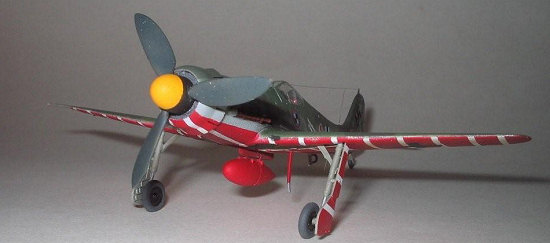 I enjoyed building this kit. It was
quick, and the result was an acceptable model. I donít think it will stand up
to the Hasegawa or Tamiya kits, but it is better than the old Airfix kit, which
of course, is about 30 years old. Iím going to get several more of these kits,
as they produce numerous P-40ís, an F4F-3 and 4, several ME-109ís, some
Russian MiGs and Yaks, and a P-39Q Aircobra, not to mention the P-47 and P-51.
What Iím waiting for is a radial engine FW-190A,F, or G. I want to see what
they do with that one.
I enjoyed building this kit. It was
quick, and the result was an acceptable model. I donít think it will stand up
to the Hasegawa or Tamiya kits, but it is better than the old Airfix kit, which
of course, is about 30 years old. Iím going to get several more of these kits,
as they produce numerous P-40ís, an F4F-3 and 4, several ME-109ís, some
Russian MiGs and Yaks, and a P-39Q Aircobra, not to mention the P-47 and P-51.
What Iím waiting for is a radial engine FW-190A,F, or G. I want to see what
they do with that one.
Try one. You might actually like it. If not, give it to your kids. It wonít be a frustrating experience for them, and I think that is the whole idea.
Kit courtesy of my Social Security income.
September 2007
If you would like your product reviewed fairly and fairly quickly, please contact the editor or see other details in the Note to Contributors.